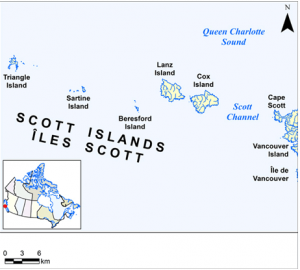
News/Reports
The Scott Islands: A Proposed Marine National Wildlife Area Regulatory strategy 60 day public consultation (2013-03-25 to 2013-05-25)
Introduction
There are marine areas of Canada’s oceans that are globally and nationally important to the survival of many species of seabirds. The federal government has enacted legislation to conserve and protect these marine areas. The Canada Wildlife Act allows important marine wildlife habitats, particularly for migratory birds and endangered species, to be set aside as National Wildlife Areas for the purposes of wildlife conservation, research and interpretation.
Why establish a National Wildlife Area around the Scott Islands?
Tufted Puffin, Scott Islands, British Columbia © Jim Lamont, 2011
The Scott Islands1 supports the highest concentration of breeding seabirds in Canada’s Pacific ocean. About 40% of the seabirds that breed in British Columbia nest there. That includes 9 of every 10 Tufted Puffins in Canada and approximately half of all Cassin’s Auklets in the world. The Scott Islands marine area2 is already an internationally recognized Important Bird Area and is one of the single most ecologically vital locations in all of the Northwest Pacific Ocean ecosystem.
Scott Islands (Triangle Island), British Columbia © Canadian Wildlife Service
Five islands make up the Scott Islands archipelago. Lanz and Cox Islands are closest to Vancouver Island shores and were designated as a Class “A” Provincial Park in 1995. The outer three islands of Sartine, Beresford, and Triangle (Anne Vallée) became provincial Ecological Reserves in 1971. The seabirds that nest on the Scott Islands need a healthy ocean, rich in their primary food sources of fish and zooplankton. Birds may travel distances of up to 85 to 120 kilometres from the Scott Islands to feed in the open ocean waters. Over 15 years of shipboard bird observation surveys of this marine region have shown widespread and extensive use by migratory seabirds. In addition, telemetry data confirmed important areas where breeding birds forage to feed themselves and their young.

